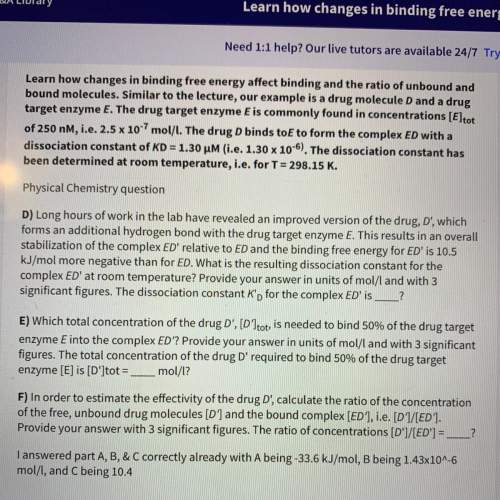
Chemistry, 18.01.2020 03:31 mirandaaa14
Learn how changes in binding free energy affect binding and the ratio of unbound and bound molecules.
similar to the lecture, our example is a drug molecule d and a drug target enzyme e. the drug target
enzyme eis commonly found in concentrations [eltot of 250 nm, i. e. 2.5 x 10-7 mol/l. the drug d binds to
eto form the complex ed with a dissociation constant of kd = 1.30 mm (i. e. 1.30 x 10-6). the dissociation
constant has been determined at room temperature, i. e. for t = 298.15 k.
physical chemistry question
c) in order to estimate the effectivity of the drug d, calculate the ratio of the concentration of the free,
unbound drug molecules (d) and the bound complex (ed), i. e. (d]/(ed), for the conditions described in part
b. provide your answer with 3 significant figures. the ratio of concentration (d]/[ed]=
d) long hours of work in the lab have reveled an improved version of the drug, d, which forms an
additional hydrogen bond with the drug target enzyme e. this results in an overall stabilization of the
complex ed relative to ed and the binding free energy for ed is 10.5 kj/mol more negative than for ed.
what is the resulting dissociation constant for the complex ed at room temperature? provide your answer
in units of mol/l and with 3 significant figures. the dissociation constant ko for the complex ed is
e) which total concentration of the drug d: (ditot, is needed to bind 50% of the drug target enzyme einto
the complex ed? provide your answer in units of mol/l and with 3 significant figures. the total
concentration of the drug d' required to bind 50% of the drug target enzyme (e) is (d']tot = /l?
f) in order to estimate the effectivity of the drug d, calculate the ratio of the concentration of the free,
unbound drug molecules [d] and the bound complex (ed), i. e. [d]/[ed). provide your answer with 3
significant figures. the ratio of concentrations (d)/(ed) =
i answered part a & b correctly already with a being -33.6 kj/mol and b being 1.43x10^-6 mol/l


Answers: 3
Another question on Chemistry

Chemistry, 21.06.2019 22:30
Explain why scientists use shared characteristics to make cladograms.
Answers: 1

Chemistry, 22.06.2019 13:00
What is the mass of 2.00 l of an intravenous glucose solution with a density of 1.15 g/ml?
Answers: 2


Chemistry, 23.06.2019 05:00
If 15 drops of ethanol from a medicine dropper weigh 0.60g, how many drops does it takes from a dropper to dispense 1.0ml of ethanol? density of ethanol is ethanol is 0.80g/ml.
Answers: 2
You know the right answer?
Learn how changes in binding free energy affect binding and the ratio of unbound and bound molecules...
Questions


Mathematics, 16.10.2020 01:01

Chemistry, 16.10.2020 01:01


Mathematics, 16.10.2020 01:01

History, 16.10.2020 01:01


History, 16.10.2020 01:01

Biology, 16.10.2020 01:01

Mathematics, 16.10.2020 01:01


Chemistry, 16.10.2020 01:01

English, 16.10.2020 01:01


Chemistry, 16.10.2020 01:01


Biology, 16.10.2020 01:01


Mathematics, 16.10.2020 01:01

Physics, 16.10.2020 01:01



